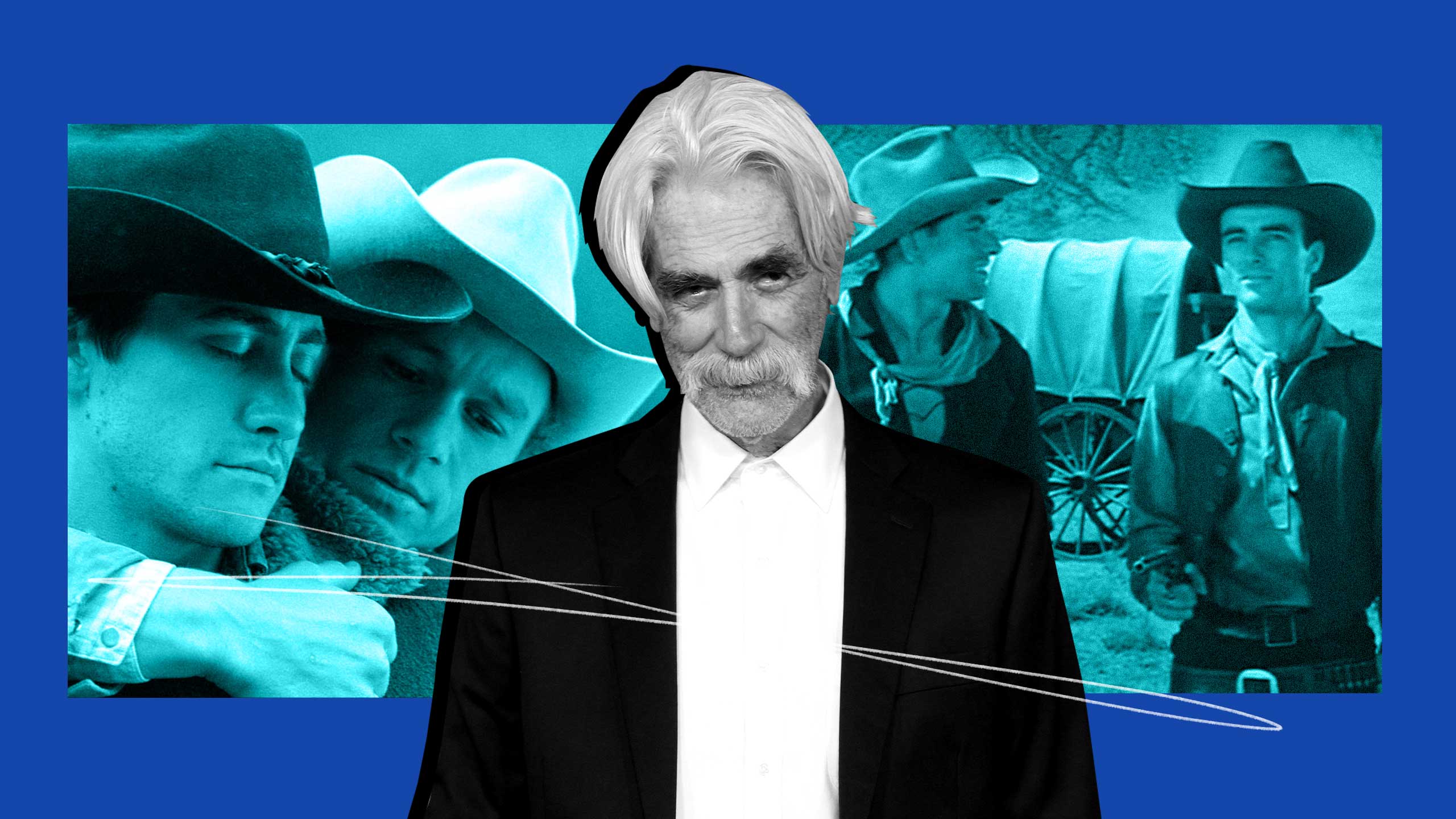It’s hard to believe that in the year 2022 people are arguing that cowboys—and by extension, western films—shouldn’t be queer.
Acclaimed actor, frequent on-screen cowboy and noted moustache owner Sam Elliott drew the ire of the internet this week after an appearance on the WTF with Marc Maron podcast where he criticized Jane Campion’s Oscar-nominated film The Power of the Dog, calling it a “piece of shit” and comparing characters, including Benedict Cumberbatch’s central cowboy, to “Chippendales dancers.”
“That’s what all these fucking cowboys in that movie looked like. They’re all running around in chaps and no shirts, there’s all these allusions to homosexuality throughout the fucking movie,” Elliott told Maron in the interview.
Besides the fact that chaps are a practical clothing item for someone working on a ranch—and that Elliott himself was born and raised in the decidedly not wild west of Sacramento, California—Elliott’s comments were not received well.
Throughout the podcast interview, Elliott posits the cattle ranching depicted in the film as an inherently straight bastion of “family,” suggesting queerneess and homosexuality imposes upon it in some way.
But I’ve got some news for Sam Elliott: movie cowboys have always been gay. Like, suuuuuper gay.
A long history of leather chaps and longing glances
As long as there have been cowboys on screen, they’ve been engaging in some playful homoeroticism and gender, whether it’s with guns, themselves or each other. The cowboy from The Village People and the overwhelming number of leather chaps that can be spotted in many queer spaces today didn’t pop into the culture fully-formed: they’re inspired by a long history of queerness and cowboys.
Classic western films of the mid-20th century feature all sorts of homoerotic tropes, from pairs of men setting off into the Wild West with only each other to rely on to rhinestone-clad singing cowboys like in 1954’s Johnny Guitar, which starred Sterling Hayden and a very butch (and chap-wearing) Joan Crawford.
And that homoeroticism came out even in the names of films themselves. Look through a selection of super cowboy John Wayne’s filmography and a few trends emerge: Rough Romance (1930), Two-Fisted Law (1932), Pals of the Saddle (1938), Blue Steel (1934) and Ride Him, Cowboy! (1930). Any one of these would make an excellent gay bar name.
Astute critics have pointed out that the setting of the so-called “wild west” is a perfect area for exploring the deep—and deeper—connections between men.
“The prairie and the wild west were often lonely, womanless places and whether they are in jail, the navy or the armies of ancient Sparta, men without women will surely turn to one another for comfort, and never say a word about it thereafter,” critic John Pattterson wrote for The Guardian in 2005.
One of the classic examples of homoeroticism in western film comes in Red River (1948), where two cowboy characters, Cherry Valance (John Ireland) and Matt Garth (Montgomery Clift) engage in a little firearm measuring contest, if you will.
The two then partake in a light-hearted shoot-out, which another character ends describing as “They was having some fun—peculiar kind of fun, sizing each other up for the future.” Later in the film, a male character accuses another of wanting to put his brand on “every rump in the state of Texas except mine.”
The “Spaghetti Western” films made in Italy during the 1960s and 1970s were particularly known for their inherent queerness. Films like The Good, the Bad and the Ugly (1966) and A Bullet for the General (1966) feature strongly bonded male friendships, where the men often express deep emotional love for each other, and eschew relationships with women in favour of spending time together.
The Brokeback Mountain of it all
That’s all to say, Brokeback Mountain didn’t invent the wheel when it comes to depicting homoeroticism in Westerns. But Ang Lee’s 2005 film—and the 1997 Annie Proulx short story it’s based on—did make all of that homoeroticism explicit in a mainstream production.
Brokeback Mountain takes all of the longing glances and emotional connections of those classic films and actually shows us the characters being in—and making—love.
Brokeback Mountain was one of the first high-profile examples of making this subtext text, but it’s been done before in queer culture: the homoeroticism of Westerns was made explicit way back in Andy Warhol’s underground film Horse (1965), which features a strip poker game between an outlaw and his captor (and yes, there are plenty of jockstraps).
Other films have followed. Beyond The Power of the Dog this year, there’s also Netflix’s film The Harder They Fall, which features a coded trans-masculine character. Although God’s Own Country, a queer film festival favourite in 2017, features a Yorkshire sheep farmer not an American cowpoke, the movie plays with all the western tropes of stereotypical masculinity, isolation and unexpected homosexual desire.
In country music, the likes of Orville Peck—a masked, cowboy-hat-wearing singer—and Drag Race alumnus Trixie Mattel are singing songs about queerness and cowboys. Even mainstream country stars like T.J. Osborne of the duo Brothers Osborne are coming out and embracing queerness in what many would call the straightest music genre. And of course, there’s openly gay Lil Nas X singing about bull riding and “Wrangler on my booty” in the smash hit “Old Town Road.”
For Elliott to say that queerness and chaps don’t belong in western films or cowboy narratives isn’t simply out-dated—it’s wrong. As long as there have been cowboys on screen, they’ve been sharing furtive glances and measuring their guns—and yes, wearing chaps.


 Why you can trust Xtra
Why you can trust Xtra


